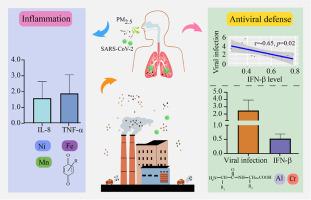An overlooked health risk of PM2.5: Elevated respiratory viral susceptibility revealed by assessing inflammatory and antiviral responses to chemical constituents
IF 3.7
2区 环境科学与生态学
Q2 ENVIRONMENTAL SCIENCES
引用次数: 0
Abstract
Epidemiological evidence linked PM2.5 exposure to increased virus transmission, yet the impact of chemical composition of PM2.5 on viral susceptibility remains unclear. We characterized the constituents of water-soluble matters (WSM) in PM2.5 from urban Guangzhou and their association with pseudotyped SARS-CoV-2 infectivity, inflammatory and antiviral responses in A549 cells. Chemical analysis revealed considerable variability in chemical composition across all samples, although all samples were dominated by inorganic ions (e.g., NO3−, SO42−, NH4+) and WSOM (e.g., lipids, oxy-aromatics), with metals constituted ∼1.2 %, primarily Cu, Fe, and Al. WSM exposure elevated viral infectivity (1.3–5.6-fold), IL-8 and TNF-α generation (1.2–5.2-fold), and suppressed IFN-β by 24 %–74 %, with minimal effects on IFN-α and surfactant proteins. An explainable machine learning analysis indicated that transition metals (e.g., Ni, V, Mn, Fe), inorganic ions (e.g., SO42−, Na+, K+), highly unsaturated oxy-aromatics (Xc ≥ 2.5, DBE ≥6) and protein1 with 0.2 < O/C ≤ 0.6 and 0.9 < H/C < 2.5 were positively linked to IL-8 and TNF-α induction, whereas trace metals (e.g., Cr, Al) and protein2 with 0.6 < O/C ≤ 1 and 1.2 < H/C < 2.5 were both associated with enhanced infectivity and IFN-β inhibition. Notably, viral infectivity remained uncorrelated with inflammatory cytokines but showed an inverse correlation with IFN-β expression consistently observed during WSM-only and WSM + virus co-exposure, suggesting that PM2.5 may impair interferon-mediated defenses to exacerbate viral susceptibility. Our study uncovers an overlooked health risk of PM2.5 thereby filling a critical gap in understanding the multifaceted health effect of PM2.5 exposure.

被忽视的PM2.5健康风险:通过评估对化学成分的炎症和抗病毒反应揭示呼吸道病毒易感性升高
流行病学证据表明PM2.5暴露与病毒传播增加有关,但PM2.5的化学成分对病毒易感性的影响尚不清楚。我们研究了广州市区PM2.5中水溶性物质(WSM)的成分及其与A549细胞中伪SARS-CoV-2传染性、炎症和抗病毒反应的关系。化学分析显示,所有样品的化学成分都存在相当大的差异,尽管所有样品都以无机离子(如NO3−,SO42−,NH4+)和WSOM(如脂质,氧芳香化合物)为主,金属成分占约1.2%,主要是Cu, Fe和Al。WSM暴露可提高病毒感染性(1.3 - 5.6倍),IL-8和TNF-α的生成(1.2 - 5.2倍),并抑制IFN-β 24% - 74%,对IFN-α和表面活性剂蛋白的影响最小。一项可解释的机器学习分析表明,过渡金属(如Ni、V、Mn、Fe)、无机离子(如SO42−、Na+、K+)、高度不饱和的氧芳香化合物(Xc≥2.5、DBE≥6)和0.2 < O/C≤0.6和0.9 < H/C <; 2.5的蛋白1与IL-8和TNF-α诱导呈正相关,而微量金属(如Cr、Al)和0.6 <; O/C≤1和1.2 < H/C <; 2.5的蛋白2都与增强的感染性和IFN-β抑制有关。值得注意的是,在WSM和WSM +病毒共暴露期间,病毒传染性与炎症细胞因子不相关,但与IFN-β表达呈负相关,这表明PM2.5可能破坏干扰素介导的防御,从而加剧病毒的易感性。我们的研究揭示了PM2.5被忽视的健康风险,从而填补了理解PM2.5暴露对健康的多方面影响的关键空白。
本文章由计算机程序翻译,如有差异,请以英文原文为准。
求助全文
约1分钟内获得全文
求助全文
来源期刊

Atmospheric Environment
环境科学-环境科学
CiteScore
9.40
自引率
8.00%
发文量
458
审稿时长
53 days
期刊介绍:
Atmospheric Environment has an open access mirror journal Atmospheric Environment: X, sharing the same aims and scope, editorial team, submission system and rigorous peer review.
Atmospheric Environment is the international journal for scientists in different disciplines related to atmospheric composition and its impacts. The journal publishes scientific articles with atmospheric relevance of emissions and depositions of gaseous and particulate compounds, chemical processes and physical effects in the atmosphere, as well as impacts of the changing atmospheric composition on human health, air quality, climate change, and ecosystems.
 求助内容:
求助内容: 应助结果提醒方式:
应助结果提醒方式:


